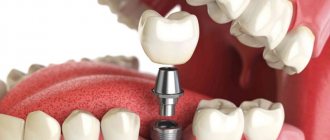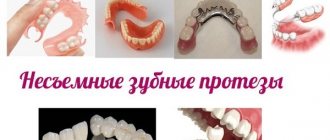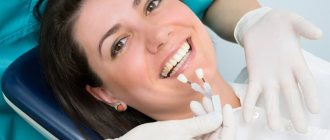Modern dentistry is undoubtedly the latest generation of implantation. Science and technology in this area are ahead of their time; the development of implantology can be compared to space developments. Continuous study of a huge number of clinical cases, analysis of results, implementation of innovative solutions, improvement of materials and types of implants has already made it so that modern dental implantation is completely painless, safe and allows you to restore an entire row of teeth even in one visit.
Modern dental implantation
Dental restoration using implants began in the mid-twentieth century. The metal rod installed in the jawbone has changed over time, and new methods of its installation have appeared. Outdated plate implants are no longer used. Doctors have moved away from the intramucosal, superiosteal method and some others. Nowadays, new generation dental implants are artificial roots made of titanium alloy, which are biocompatible with the human body, do not cause allergic reactions, are durable and reliable for chewing loads. They play the role of real roots, preventing the atrophy of bone tissue that would inevitably occur in the place of lost teeth. And new implantation protocols make it possible to quickly solve the problem of the absence of one or all teeth, without preparing healthy teeth and even avoiding sinus lifting and increasing the volume of bone tissue in case of its deficiency.
Dental restoration forever!
Installation of a two-stage implant ROOTT (Switzerland) - RUB 27,000. 32,000 rub.
PIC-Optima as a replacement for titanium implants
PIK-Optima is a new biological polymer material from which it is possible to produce implants that are not inferior in their characteristics to titanium analogues. This material was created by French scientists. In 2005, a pilot batch of artificial dental roots was produced from it for the first time. Implants made from PIC-Optima biopolymer have the following advantages:
- very long service life;
- maximum similarity of the material to the bone structure of the jaw;
- the material does not cause an allergic reaction in patients;
- high resistance to chemical influences.
It is also noteworthy that PIK-Optima can be used both to strengthen soft tissues and to strengthen and even replace bone tissue in the oral cavity. Moreover, unlike titanium alloys, this material is very plastic. This allows implants to be manufactured to a given size as accurately as possible, and the flexibility of the material does not provoke bone tissue destruction.
Modern methods of dental implantation
The dental clinic can offer the patient atraumatic, fast and effective modern implantation methods.
Express implantation
(simultaneous implantation). The method of implanting a titanium pin directly into the socket of an extracted tooth is used. Advantages of the one-stage flapless method:
- there is no need to cut the tissue, suturing it, which means less time will be spent on healing and removal of sutures;
- the non-traumatic nature of the operation, which is morally easier for a person to bear;
- installation lasts up to 15 minutes.
In what cases is this transgingival method of modern dental implantation suitable:
- in the absence of one or all teeth on the upper or lower jaw;
- There is a time limit for recovery (it must be done urgently).
In addition, there should not be severe inflammation of the gums and insufficient bone tissue (consultation with a doctor is necessary to resolve these issues).
Implantation with immediate loading
(one-stage implantation). Just a couple of decades ago, after implantation, it was necessary to walk without a visible tooth, without a crown or prosthesis, for the entire period of osseointegration (3-6 months). Which, naturally, caused terrible psychological discomfort in any patient. The latest generation of implantations allows you to immediately install an adaptive prosthesis. A person leaving the dentist's office can smile, speak without defects and eat normally. During the entire period of engraftment of the titanium pin, its fusion with tissues and blood vessels, a lightweight temporary prosthesis allows you to get used to the presence of the orthopedic structure in the mouth and not experience discomfort in everyday life.
Zirconium dioxide implants
Implants made from zirconium dioxide successfully replace metal structures. In addition, zirconium implants are implanted into bone tissue much faster than titanium ones. Zirconium dioxide is highly resistant to mechanical loads, both static and dynamic. It is quite easy to process and integrate into the jaw bones.
The advantages of the material include:
- high strength;
- long service life;
- no allergic reaction in patients.
Zirconium dioxide, unlike titanium alloys, does not release metal microparticles into the soft tissues of the oral cavity.
Indications:
- absence of one, several teeth or complete edentia.
Dental implantation using a surgical template
. The use of 3D modeling helps the doctor accurately plan the operation, eliminating all risks and undesirable consequences. The modern method of implantation using a surgical template is the key to the successful work of an implantologist and orthopedist.
After a CT (computed tomography) scan, the doctor outlines the location of the implants in the program, which he then works with to decide at what angle and what type of implant to install. And the technician is already preparing to make temporary crowns and prostheses, which will be fixed on the day of implantation.
Implants with tapered abutment connection
Such structures are non-demountable. Their conical abutment ensures uniform load over the entire area of the implant, which dramatically reduces the likelihood of root loosening while chewing solid food. Such implants can be installed below the level of the cortical bone, in the area of which there is very little blood circulation.
The advantages of this technology are:
- monolithic design;
- uniform load distribution over the entire area of the implant;
- impossibility of penetration of pathogenic microorganisms to bone tissues:
- fast and very tight implantation of the implant into bone tissue;
- the technology does not interfere with normal blood circulation in the oral cavity;
- natural appearance;
- long service life.
Indications:
- absence of several teeth or complete edentia;
- a complex clinical case that requires a particularly careful approach.
Implantation
All-on-4 and All-on-6
. Modern dental implantation “All on four” or “All on six” allows you to reduce the financial burden of restoring the entire dentition. By implanting only 4 or 6 titanium rods, you can install a complete denture on the jaw with 10-12 artificial crowns. Installing an implant instead of each tooth would require more money and time.
Free consultation on the cost of treatment in our dentistry
Leave a request and the clinic administrator will contact you within 15 minutes!
Also, the advantages of mini-implantation include:
- Gentle technology for implantation. The implantologist will simply screw the titanium screw into the bone, without cutting tissue;
- Affordable price for the implantation system and services in general. It is possible to restore the entire dentition for an amount starting from 100,000 rubles;
- Mini-implantation does not place high demands on the condition of bone tissue, which means it can be performed without prior osteoplasty and if significant bone atrophy is detected during diagnostics.
Naturally, you cannot remove a prosthesis installed on mini-implants at will and on your own - for this you will have to consult a doctor.
Indications:
- absence of most teeth or complete edentia;
- inability to wear a removable lamellar denture.
This modern implantation method allows people with removable dentures to securely fix it.
Complex implantation
. “All inclusive” in dental treatment. In one visit to the dentist, teeth are removed (if necessary) and an implant is inserted. A method for immediately restoring multiple teeth. Prosthetics on 6-12 implants with a fixed prosthesis.
Implantation using classical technology: features, pros and cons
It was already mentioned above that classical implantation is the longest option for restoring lost teeth. Pauses during classical implantation will have to be made both for the period required for tissue restoration after extraction of diseased teeth and for the time required for complete osseointegration of the implanted implant. The total time for classical implantation is 7-8 months.
USEFUL TO KNOW: Two-stage implantation places high demands on the condition of the bone tissue. It must have sufficient volume and density for high-quality fixation of the implant. Therefore, if the indicators are insufficient, preliminary osteoplasty is performed, and after tooth extraction, a pause of two to three months is maintained, which is necessary for complete bone regeneration.
Indications:
- impossibility of two-stage implantation;
- absence of 3 teeth to complete absence;
- urgency of recovery.
Resmile
. Implantation technology without cuts or sutures. The transgingival method of implanting a titanium root is atraumatic, healing occurs quickly. The combination of implants from one system increases the success rate and minimizes complications. This is facilitated by a titanium-based ceramic composite prosthesis, which is installed on the 4th day and does not require replacement subsequently; it is permanent.
How does implantation work?
The duration of implantation depends on the chosen technique, but in each case the procedure is divided into 4 stages:
- planning;
- preparation for surgery;
- surgery to install an implant;
- fixation of a crown or bridge.
Before proceeding with the operation, it is necessary to determine whether intervention is possible in a particular case. During planning, the implantologist assesses the condition of the oral cavity and jaw bone tissue, studies the patient’s medical history to exclude contraindications to the procedure.
Implantation is a complex operation that cannot be performed for some chronic pathologies. To exclude them, the patient takes blood tests and takes an x-ray of the jaw bones. At this stage, the doctor decides on the need for prosthetics and gives recommendations on the choice of technique.
New generation of dental implants
Implant manufacturers are constantly researching and developing new types of dental implants. By studying numerous clinical pictures from the practice of doctors, they create new types of threads, improve the alloy, and change the method of processing the surface of the product.
New generation dental implants:
- Compression implants. The very tight contact of titanium and tissue promotes rapid osseointegration.
- Multi-units with a rotating abutment head, screw fastening for fixing the prosthesis with screw fixation.
- Basal implants are placed where there is critically little bone tissue. Their implantation occurs in deeper, dense layers.
The titanium alloy is being improved, and the grinding and processing of the implant surface takes place in several stages. This is sandblasting and etching. The main thing is to achieve the necessary roughness of the root part of the implant for successful survival and cleanliness, the absence of traces of organic matter during production. The necks are made smooth to prevent the accumulation and reproduction of bacteria on them. Every nuance is taken into account. And the creation of a wide range of implants allows the doctor to comprehensively use different types of artificial roots within one operation.
Modern systems have a warranty of 25-50 years, and many manufacturers provide a lifetime warranty. The survival rate of implants takes from three months to six months, and the success of osseointegration of new generation dental implants reaches 98.5%.
New developments by Malaysian scientists
Scientists from the Department of Restorative Dentistry at a Malaysian university have developed a new type of implant designed for older age groups of patients. Their work was based on the creation of a special bioceramic coating made of magnesium silicate for the rod and abutment, which will ensure rapid fusion with bone tissue.
The researchers also developed a new method for making titanium structures. It involves microwave sintering of the implant after coating it with titanium powder. This favors rapid implantation, improvement of the aesthetic effect, as well as the quality of implantation.
The leader of a group of Malaysian scientists, Alirez Yagubi, believes that the creation of personalized dental systems is a promising area of biotechnology. Each patient is unique and requires an individual approach.
Development continues, clinical trials of new implants are being conducted. In the future - increasing the service life of structures, creating high-quality products accessible to all categories of the population.
Alternative Methods
You can restore the integrity of the dentition using:
- removable prosthetics. It is inexpensive and can immediately replace all lost teeth. But it takes a long time to get used to such voluminous structures; at first they can cause a gag reflex. For more reliable fixation, additional means such as Corega are often used to prevent the prosthesis from accidentally falling out. Aesthetics are poor, and tissue atrophy progresses inexorably. With prosthetics on implants this is impossible.
- prosthetics with a bridge supported by adjacent teeth. In this case, the supporting teeth grind down and become weaker. With constant chewing load, such structures may collapse over time.
- crowns If the tooth root is preserved, it can be restored with a crown. If the root is destroyed, then the only options left are single implantation or a bridge;
- classical implantation. A two-stage protocol involves installing a root-shaped implant, waiting for it to engraft into the bone, and only then fixing the permanent prosthesis. This is a long process (from 3 to 6 months), during which the titanium rod is completely osseointegrated into the jaw bone.
Japanese scientists create implants similar to natural teeth
Creating an artificial organ biologically identical to a natural one is a difficult task. Japanese scientists under the leadership of Professor Takashi Tsuji coped with it “excellently.” They created a biohybrid dental implant that completely recreates the structure and function of a natural tooth. The development is based on coating a conventional titanium implant with hydroxyapatite and stem cells from dental follicles.
Studies have shown that after installation of the implant, active regeneration of periodontal tissue occurs and it begins to function like a natural tooth. Capable of feeling pain and responding to mechanical stress.
The work of scientists is still ongoing; now the material is not yet used for dental purposes . The biohybrid implant is a great achievement, which in the near future will be used to restore lost teeth.
Price
Modern dental implantation is more expensive than prosthetics. The cost of treatment depends on several factors:
- chosen method;
- use of a surgical template;
- number of implants;
- company manufacturer;
- material of prosthesis, crown;
- qualification of an implantologist.
For example, the price of one-stage implantation with a temporary crown is about 40,000 rubles, the All-on-4 technology of one jaw with an adaptive prosthesis will cost from 190,000 rubles, one-stage implantation with complete edentia of one jaw on 6 compression implants and a temporary prosthesis - in the region RUB 265,000 The cost item may increase due to additional diagnostics and prosthetic materials.
Stages of the implantation procedure
In modern times, implantation is carried out in several stages. This is more preferable for dentists and patients. The procedure is divided into the following stages:
- Initially, the patient is pre-consulted to identify contraindications and indications for the procedure. Dental, social and somatic factors may serve as contraindications.
- Then a detailed diagnosis is made using computed tomography and stereolithography. At this stage, the entire procedure is planned.
- Treatment measures are discussed with the client. He is provided with detailed information about the procedure and an agreement is concluded between the dental clinic and the patient.
- Dental therapists, orthodontists and periodontists prepare the workplace for the procedure.
- During the procedure, bone tissue may or may not be built up, and alveolar ridges and jaw bones may also be reconstructed. If necessary, they can make a somatic correction. Indications for the use of correction are the presence of diabetes mellitus and other diseases.
- At this stage, an implant is installed, defects are removed and the functions of the musculoskeletal system are restored.
- As a result of the procedure, the patient’s condition is monitored and a preventive examination is performed.
Where to go for the latest generation of dental implants
Only dental clinics with technologically advanced diagnostic and surgical equipment and highly qualified staff can offer a choice of modern methods of dental implantation and a guarantee for their work.
The table shows several Moscow clinics where you can restore a beautiful smile in an advanced way. We advise you to find out the cost and current promotions directly on their websites.
| dental clinic | Website |
| Center for Dental Implantology ROOTT (RUTT) | https://dentalroott.ru |
| Dentum dentistry | https://dentumclinic.ru |
| City-Dent | https://city-dent.rf |
| The president | https://www.prezi-dent.ru |
| Center Family Dentistry | https://family-dental.ru |
When is a prosthesis installed?
Depending on the selected dental implantation technology, the doctor may choose one of the following prosthetic models:
Delayed loading . With this type, a fixed prosthesis is installed only 4-6 months after the procedure. This period is necessary for complete implantation. During this period, the patient is fitted with a removable (temporary) orthopedic structure. However, its functionality is significantly lower than constant, so the patient must strictly follow the doctor’s recommendations. This type of prosthetics is used for two-stage implantation.
Immediate load . Fixed prostheses are immediately installed on the implants. This method is used for one-step installation. However, you need to understand that one-stage does not mean in one step. It is so named because no more than three days pass between implantation and prosthetics. Fixed orthopedic structures can immediately absorb the chewing load, although, of course, you should not start with hard products.
Accelerated (early) load . In this case, the non-removable orthopedic structure is not installed immediately, as with the one-stage method, but not after six months, as with the two-stage method. If indicated, the dentist can install it 2-4 weeks after implantation. This is possible if certain implants were used during treatment, for example, Straumann. Thanks to their special coating, they promote rapid healing and growth of bone tissue cells.
Rehabilitation after implantation
The main rehabilitation after the procedure is the implantation. On average, this process takes 4-6 months, but much depends on the implants used and the characteristics of the patient’s body. Everything here is individual. During the rehabilitation period, the patient must strictly follow the recommendations of the attending physician and regularly visit the dental office to monitor the process of osseointegration of the implant. Violation of the doctor’s recommendations may negatively affect the condition of the installed orthopedic structures or lead to health problems.











